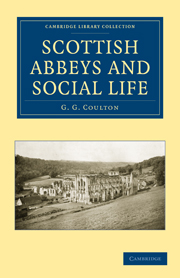Book contents
- Frontmatter
- Contents
- LIST OF ILLUSTRATIONS
- Preface
- Chapter I Celtic Monachism
- Chapter II The Monastic Rules
- Chapter III Monastic Revenues
- Chapter IV How Endowments Came (I)
- Chapter V How Endowments Came (II)
- Chapter VI Monks and Parishes (I)
- Chapter VII Monks and Parishes (II)
- Chapter VIII Charity (I)
- Chapter IX Charity (II)
- Chapter X Monk and Peasant (I)
- Chapter XI Monk and Peasant (II)
- Chapter XII Monastic Housekeeping
- Chapter XIII Church and Scriptorium
- Chapter XIV The Monastic Chronicler
- Chapter XV Schools
- Chapter XVI Art and Learning
- Chapter XVII Professions and Business
- Chapter XVIII Visitation (I)
- Chapter XIX Visitation (II)
- Chapter XX A Voice from the Cloister
- Chapter XXI Conclusion
- Appendixes
- List of Authorities
- Index
Chapter II - The Monastic Rules
Published online by Cambridge University Press: 05 August 2011
- Frontmatter
- Contents
- LIST OF ILLUSTRATIONS
- Preface
- Chapter I Celtic Monachism
- Chapter II The Monastic Rules
- Chapter III Monastic Revenues
- Chapter IV How Endowments Came (I)
- Chapter V How Endowments Came (II)
- Chapter VI Monks and Parishes (I)
- Chapter VII Monks and Parishes (II)
- Chapter VIII Charity (I)
- Chapter IX Charity (II)
- Chapter X Monk and Peasant (I)
- Chapter XI Monk and Peasant (II)
- Chapter XII Monastic Housekeeping
- Chapter XIII Church and Scriptorium
- Chapter XIV The Monastic Chronicler
- Chapter XV Schools
- Chapter XVI Art and Learning
- Chapter XVII Professions and Business
- Chapter XVIII Visitation (I)
- Chapter XIX Visitation (II)
- Chapter XX A Voice from the Cloister
- Chapter XXI Conclusion
- Appendixes
- List of Authorities
- Index
Summary
It is extremely doubtful whether St Columba drew up any definite and detailed rule of life for his monks. His contemporary of the same name, also called Columban, and also an Irishman by birth, spent his life in mission-work on the Continent; he founded monasteries in France, Switzerland and Italy; and there does exist a brief strict written Rule ascribed to him. But that and similar Rules soon died out; there is no trace of them when we come to the date at which real documentary Scottish history may be said to begin, let us say, with Malcolm Canmore and St Margaret about the time of the Norman Conquest of England. By that time, monachism was highly developed and very definitely organized throughout Europe, and almost all of these monks followed one of two Rules, the Benedictine or the Augustinian. I must begin, therefore, with a very brief sketch of these two Rules.
St Benedict's was probably drawn up in 529, a year famous for two other events of capital importance. For it was in 529 that Justinian set his ministers to that codification, or rather, that summarization, of Roman law which enabled it to stand like a rock through the whole Middle Ages, to colour all politics as well as all legislation, and to lie in a very real sense at the foundation of all modern legal codes. And it was in that same year that Justinian committed himself to an act far less laudable, though important in its immediate consequences; he closed the Schools of Athens and drove out the philosophers, thus extinguishing all that remained of organized non-Christian learning in his empire.
- Type
- Chapter
- Information
- Scottish Abbeys and Social Life , pp. 21 - 37Publisher: Cambridge University PressPrint publication year: 2010First published in: 1933

